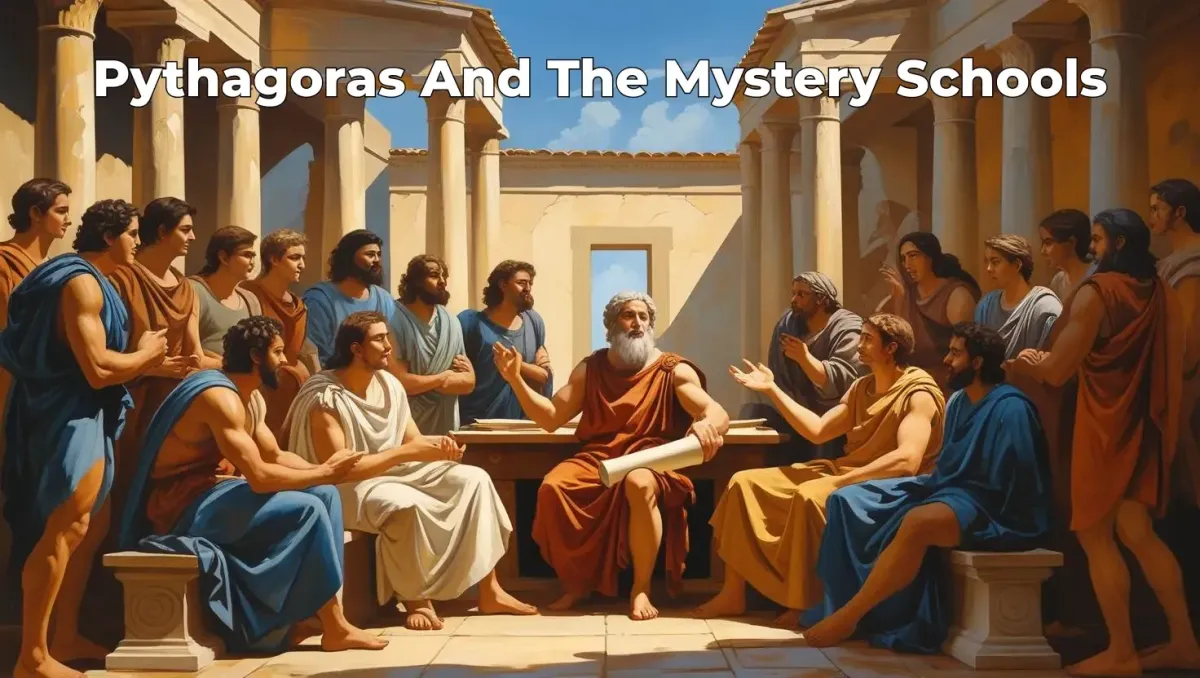
Pythagoras and the Mystery Schools: Numbers, Music, and Harmony
Few names echo through history with the same mystical resonance as Pythagoras. To most people, he’s remembered as the mathematician behind the Pythagorean theorem. But in the context of the mystery schools, Pythagoras was much more: a sage, philosopher, and initiatory teacher whose teachings on numbers, music, and harmony became pillars of sacred science.
For Pythagoras and his followers, numbers were not simply tools for calculation. They were living symbols of cosmic order. Music was not only entertainment, but a bridge between human consciousness and universal harmony. His teachings helped shape the spiritual foundations of the mystery schools — and continue to inspire seekers today.
New to mystery schools? Start with our overview article “What Are Mystery Schools?” and then visit the Mystery School hub for classes, courses and next steps.

Pythagoras the Initiate
Pythagoras (c. 570–495 BCE) was more than a mathematician. Ancient accounts suggest he travelled widely, studying with Egyptian priests, Babylonian astrologers, and possibly even Indian sages. These experiences infused his philosophy with the breadth of the world’s spiritual traditions.
When he returned to Greece, he founded a mystery school at Croton in southern Italy. This school combined philosophy, mathematics, ritual, and ethical living. Admission was selective, discipline was strict, and initiates were required to undergo periods of silence to cultivate inner stillness and receptivity.
For more on the culture of initiation, see What Are Mystery Schools? The Hidden Lineage of Ancient Wisdom.
Pythagoras — what we can say with confidence (plain English)
Who/where: Pythagoras (c. 570–490 BCE) founded a community at Croton in Magna Graecia; it mixed philosophy, ritual and a disciplined way of life. (Encyclopedia Britannica)
Core ideas: the transmigration of the soul (metempsychosis) and an ethical routine intended to purify and educate. (Stanford Encyclopedia of Philosophy)
Number & harmony: early Pythagoreans linked number, musical ratio, and cosmic order—seed of “harmony of the spheres.” (Encyclopedia Britannica)
Two strands: later sources describe akousmatikoi (sayings/ritual) and mathematikoi (more theoretical/mathematical) within the movement. (Stanford Encyclopedia of Philosophy)
Women in the circle: names like Theano, Damo, Myia appear in ancient lists; Pythagorean communities gave women unusually visible roles for the time. (Stanford Encyclopedia of Philosophy)
Numbers, ratio & harmony (what they actually did)
Consonance by ratios: simple whole-number ratios (e.g., 2:1, 3:2, 4:3) explain musical intervals; later Pythagorean tuning keeps fifths pure and shows the math–music link clearly. (Encyclopedia Britannica)
Not “Pythagoras’ theorem” alone: the right-triangle relation was known in earlier cultures (e.g., Babylonian tablets like Plimpton 322); Greek work systematised and proved it within geometry. (Encyclopedia Britannica)
Myths vs history (quick clarifications)
Vegetarian? Beans? Ancient testimonies disagree—some present strict abstention, others say he ate certain meats. Treat diet rules as varying by group and period. (Stanford Encyclopedia of Philosophy)
Harmony of the spheres: a formative symbolic idea about cosmic order, not an audible soundtrack of space. (Encyclopedia Britannica)
Politics & backlash: Pythagorean circles engaged local civic life in S. Italy; ancient reports describe anti-Pythagorean uprisings that scattered communities. (Encyclopedia Britannica)
Numbers as the Language of the Cosmos
At the heart of Pythagorean teaching was the idea that “All is number.” Numbers weren’t just abstract concepts — they revealed the patterns of creation itself.
One represented unity, the source of all.
Two symbolised duality and polarity — light and dark, male and female.
Three embodied harmony and balance, the union of opposites.
Four stood for material stability, represented by the square.
Together, these formed the Tetractys, a triangular arrangement of ten dots revered by Pythagoreans. It symbolised the unfolding of the cosmos from unity into multiplicity.
To see how this idea evolved into Renaissance esotericism, revisit Mystery Schools in the Renaissance: Revival of Hidden Knowledge.
Music of the Spheres
One of Pythagoras’ greatest insights was the connection between numbers and music. By experimenting with strings of different lengths, he discovered mathematical ratios that produced harmonious sounds.
This revelation led to the concept of the “music of the spheres.” Pythagoras taught that the planets and stars moved according to mathematical ratios, producing a cosmic symphony inaudible to human ears but resonant in the soul.
Harmony in music mirrored harmony in the cosmos.
Disharmony in life reflected a disconnection from these cosmic ratios.
By aligning ourselves with universal harmony, we could restore inner and outer balance.
This connects closely with Sacred Geometry: Patterns of the Divine in Mystery School Teachings.
The Ethical Life of Harmony
For Pythagoras, the pursuit of harmony wasn’t just intellectual — it was practical and ethical. His school emphasised:
Vegetarianism as a way of honouring life and refining the body.
Silence and reflection to cultivate inner clarity (Reflective Psychology and Psychism: The Inner Work of Illumination).
Communal living to embody principles of justice and cooperation.
Self-discipline to purify the soul and prepare for higher wisdom.
The Pythagorean life was, in essence, a spiritual training programme — one that sought harmony not only in thought but in every aspect of living.
Numerology and Esoteric Symbolism
Pythagoras also laid the foundation for what would later become numerology. He believed that numbers held symbolic meanings that could reveal insights into the self, the cosmos, and destiny.
The number 7 represented spiritual perfection.
The number 12 symbolised cosmic order (seen in zodiac signs and months).
The number 360 reflected cycles of wholeness.
These ideas profoundly influenced later esoteric traditions, including Kabbalah’s sefirot (Kabbalah and Hermetic Qabalah: The Tree of Life in Mystery Schools) and Hermeticism’s principles of correspondence (The Hermetic Principles: Universal Laws of the Mystery Schools).
Pythagoras’ Influence on Later Mystery Traditions
The impact of Pythagoras rippled across centuries:
Plato absorbed Pythagorean ideas of harmony and the soul, embedding them in his philosophy.
Neoplatonists such as Iamblichus connected Pythagoras with theurgy (Theurgy and Ritual Mastery: Invoking the Divine in Mystery School Initiation).
Renaissance thinkers revived Pythagoras’ sacred mathematics and musical cosmology, weaving them into alchemy and Kabbalah.
Modern esotericists still use numerology and harmonic theory as tools for self-discovery and spiritual alignment.
Even today, Pythagoras is recognised not only as a mathematician but as one of the founding sages of Western esotericism.
Pythagoras and the Inner Gold of Harmony
In the mystery schools, Pythagoras’ teachings revealed that transformation was not about escaping the world but learning to live in harmony with it. By tuning our inner being to the cosmic order, we rediscover the “music of the spheres” within ourselves.
Numbers remind us of the patterns that shape existence.
Music reminds us of the harmony we can live in daily life.
The Pythagorean path reminds us that wisdom is both rational and mystical, both cosmic and personal.
To explore how harmony flows into spiritual practice, see Esoteric Meditation: Initiatory Practices for Inner Vision.
Safety & discernment — a quick note
Use Pythagorean language to grow clarity and agency, not to chase miracle claims. Avoid groups that leverage secrecy, pressure or special-powers marketing. Prefer transparent pricing, refunds, boundaries and aftercare; if your body says “no,” pause and seek another view.
Next Steps On Your Mystery School Path
If this checklist has brought some clarity, take a moment to notice how you feel. Relieved? Sad? Angry that you weren’t given these tools sooner? All of that is welcome.
When you’re ready, you can:
Use this checklist to review any school you’re considering – or already part of.
Visit the Mystery School hub and notice how your head, heart and body respond as you read.
Take a gentle next step with 7 Hermetic Principles (Course) if you’d like to experience Mystery School teaching in a container that values consent, pacing and nervous-system care.
Above all, remember: you are allowed to choose spaces that feel safe enough for your whole being – not just impressive enough for your mind.

Pythagoras’ mystery school left a timeless inheritance — the understanding that numbers and harmony are keys to both the cosmos and the soul.
At the Bright Beings Academy Mystery School, you can study Pythagoras alongside other great sages like Hermes Trismegistus, John Dee, and Leonardo da Vinci, uncovering the wisdom that shaped ancient and modern spirituality.

FAQs on Pythagoras and the Mystery School Teachings
Was Pythagoras only a mathematician?
No. He was also a philosopher, mystic, and teacher of a mystery school that combined numbers, music, ethics, and spiritual discipline.
What is the Tetractys?
A sacred triangular symbol of ten dots used by Pythagoreans to represent the unfolding of creation from unity into multiplicity.
What did Pythagoras mean by the “music of the spheres”?
That the movements of celestial bodies follow mathematical ratios, producing a harmony that, though inaudible, resonates in the soul.
How did Pythagoras influence later mystery schools?
His ideas shaped Platonic philosophy, Neoplatonism, Renaissance esotericism, and modern numerology.
Did Pythagoras prove “his” theorem?
The relation pre-dates him (see Babylonian evidence); Greek mathematicians later embedded rigorous proof culture around it. (Encyclopedia Britannica)
What is metempsychosis?
A doctrine of soul transmigration (rebirth across lives) tied to ethical discipline and ritual. (Stanford Encyclopedia of Philosophy)
Were there really two kinds of Pythagoreans?
Later sources distinguish akousmatikoi (sayings/ritual) and mathematikoi (theorists). It’s a useful lens, though history is messy. (Stanford Encyclopedia of Philosophy)
Did Pythagoreans ban beans and meat?
Sources conflict; dietary rules likely varied by circle and era. Don’t force one rulebook onto all Pythagoreans. (Stanford Encyclopedia of Philosophy)
What’s the “music of the spheres”?
A Pythagorean idea that cosmic order mirrors musical ratio—best read as symbol/metaphor, not literal sound. (Encyclopedia Britannica)
Did they include women?
Yes—lists of Pythagorean women survive; women could study and lead within some circles. (Stanford Encyclopedia of Philosophy)
Further reading
Neoplatonism and Theurgy: The Simple Map Behind Western Mysticism
The Emerald Tablet and As Above, So Below: A Plain-English Explainer
Alchemy Stages: Nigredo to Rubedo — The Inner Transformation Map
How to Vet a Mystery School: Ethics, Fees, Promises & Red Flags
I look forward to connecting with you in my next post.
Until then, be well and keep shining.
Peter. :)
